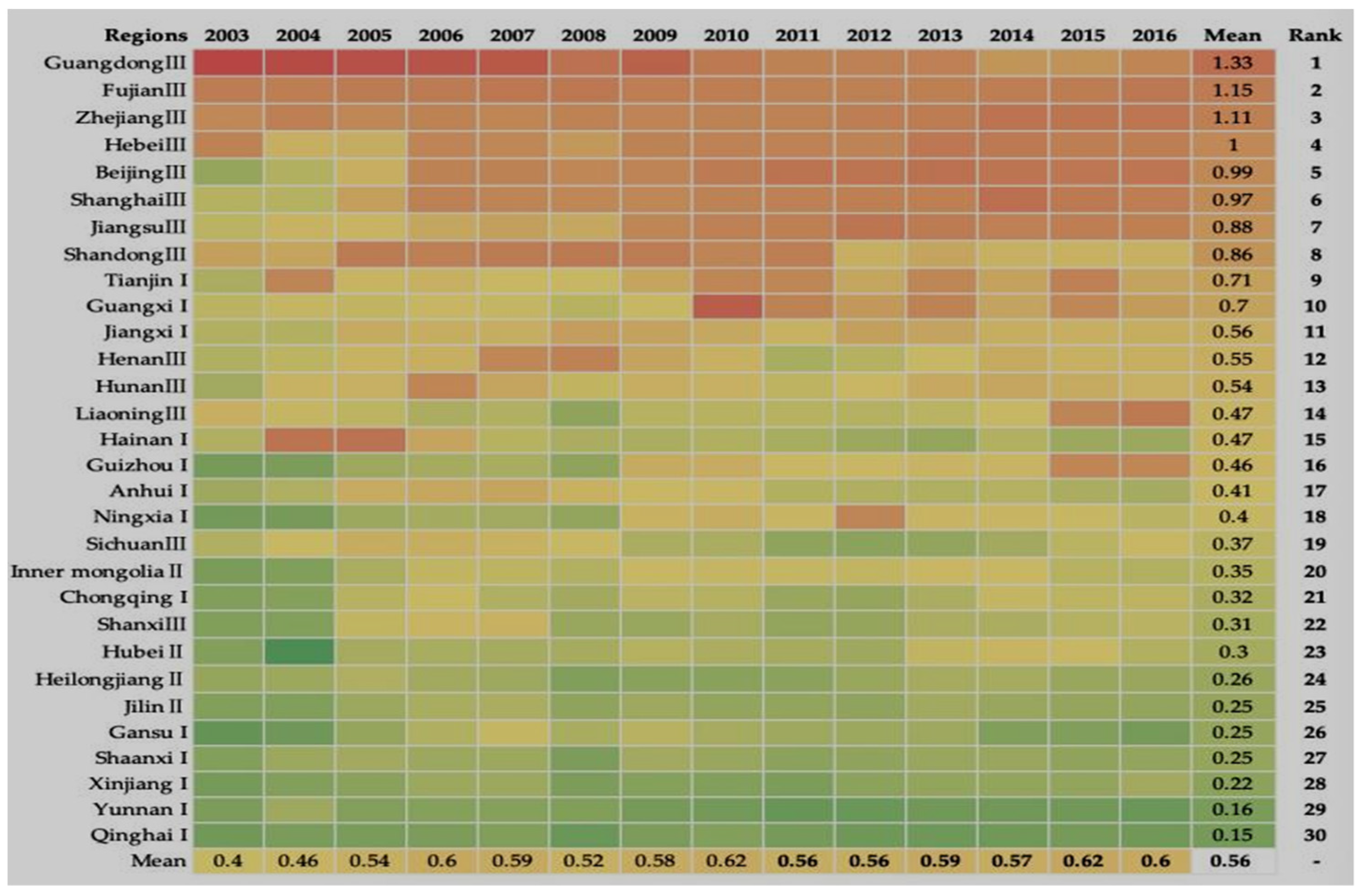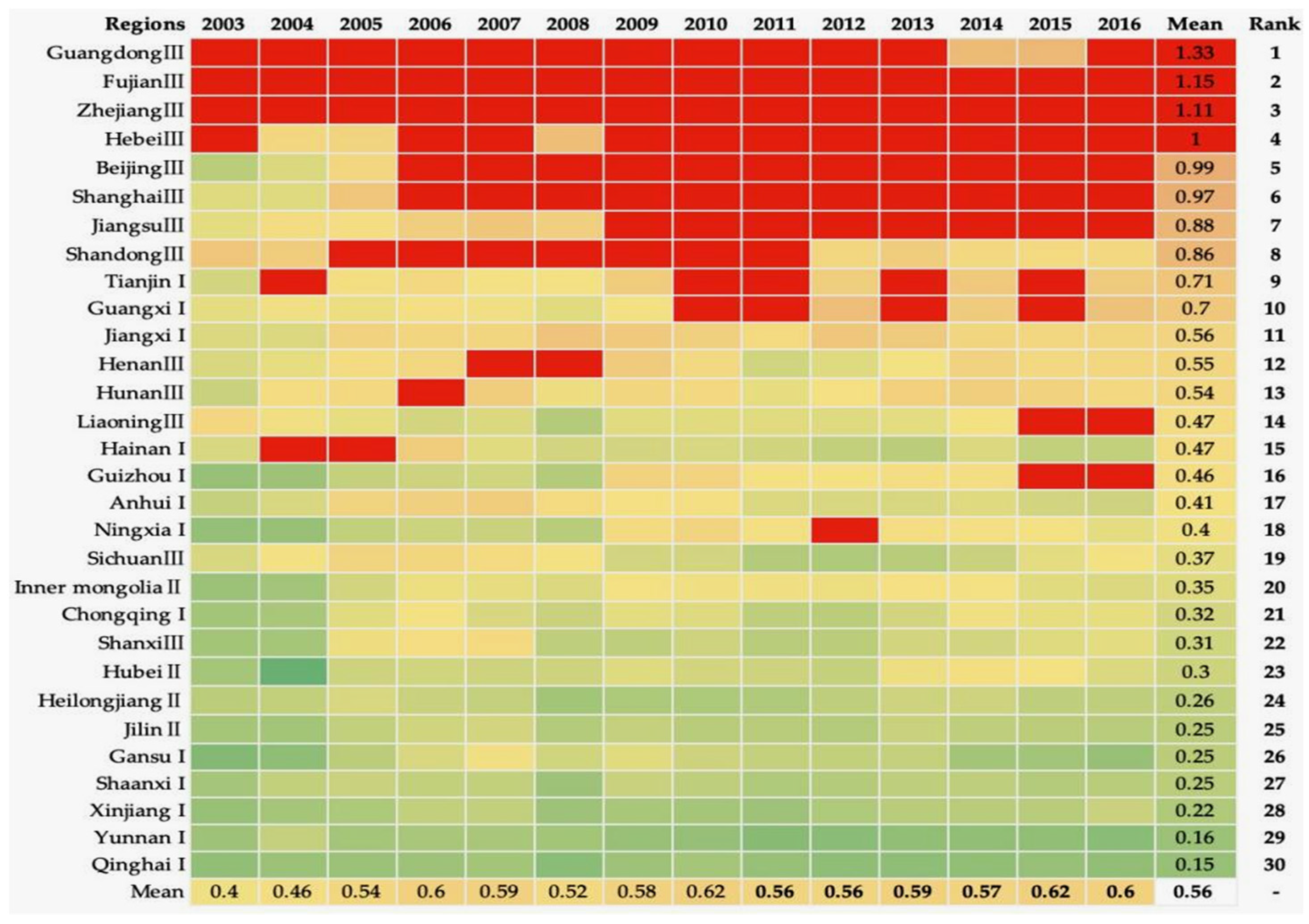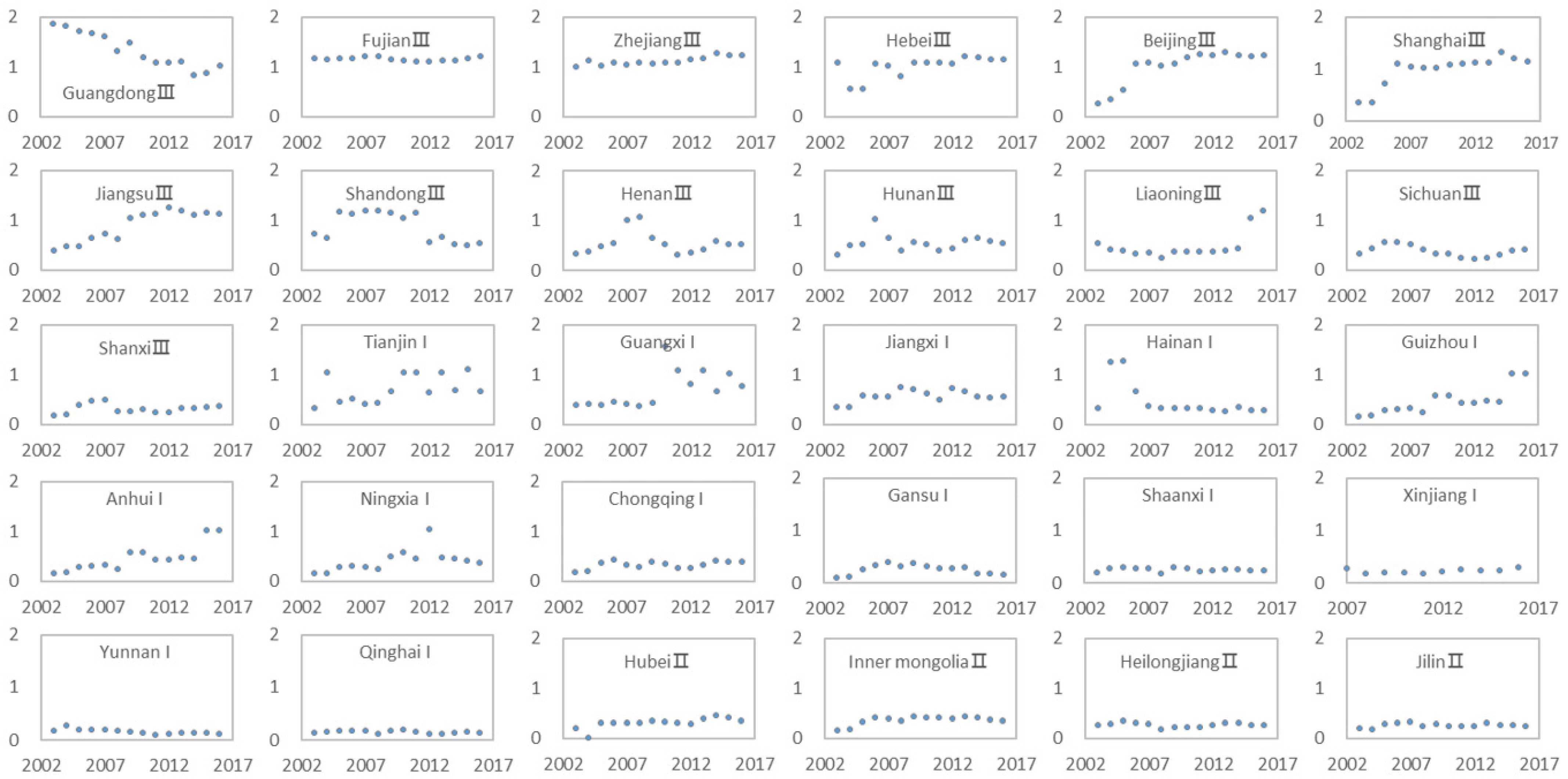
| Version | Summary | Created by | Modification | Content Size | Created at | Operation |
|---|---|---|---|---|---|---|
| 1 | Yongrong Xin | -- | 2169 | 2022-05-17 16:47:20 | | | |
| 2 | Yongrong Xin | + 637 word(s) | 2806 | 2022-05-17 16:52:07 | | | | |
| 3 | Yongrong Xin | + 1 word(s) | 2807 | 2022-05-17 16:52:44 | | | | |
| 4 | Rita Xu | Meta information modification | 2807 | 2022-05-18 03:13:53 | | |
Video Upload Options
With the increase of resources and environmental constraints in the world, the environmental cost has become a problem affecting the sustainable development of the logistics industry in all countries. Carbon emissions are an important part of any environmental cost assessment. How to evaluate the impact of green GDP and regional efficiency of the logistics industry, especially under the constraint of carbon emissions, is of great significance for realizing green and sustainable development.
1. Introduction
2. Efficiency Spatial Pattern and Analysis of China’s Logistics
2.1. Efficiency Spatial Pattern of China’s Logistics
| Groups and Mean | L | E | C | G | Ca |
|---|---|---|---|---|---|
| 1 | 12.75 | 22.44 | 480.35 | 338.40 | 162.23 |
| N | 13 | 13 | 13 | 13 | 13 |
| 2 | 23.23 | 241.82 | 708.19 | 599.22 | 317.14 |
| N | 4 | 4 | 4 | 4 | 4 |
| 3 | 33.48 | 30.83 | 998.87 | 1128.5 | 396.39 |
| N | 13 | 13 | 13 | 13 | 13 |
| Total | 23.13 | 55.32 | 735.42 | 715.53 | 284.35 |
| N | 30 | 30 | 30 | 30 | 30 |
2.2. Evaluation and Analysis of the Efficiency of China’s Regional Logistics Industry

2.2.1. Analysis of the Comprehensive Efficiency of China’s Regional Logistics

2.2.2. Analysis of the Spatial Pattern Evolution of Regional Logistics Efficiency
2.2.3. Time Evolution Analysis on Comprehensive Efficiency of Regional Logistics

3 Conclusions and Policy Implications
The comprehensive technological efficiency (TE) of each region from 2003 to 2016 was decomposed into pure technological efficiency (PTE) and scale efficiency (SE). And analyze its change trend and regional differences. At the same time, the input redundancy ratio of various elements in each region is analyzed. By projecting the production frontier of the logistics in each region, researchers could not only understand the use of its factor input, but they could also analyze the reasons for its ineffectiveness and determine the degree of its attribute value for improvement and the ideal value of input-output.
The results show that: The proportion of effective years of regional logistics in comprehensive efficiency was low, and there were obvious deficiencies between regions due to the low level of PTE and low SE in most areas. During the studied time period, the efficiency of logistics in most regions showed an upward trend. In a few areas, there was a slight deterioration inefficiency, or little change whatsoever. However, the comprehensive efficiency of logistics has gradually been improving. According to the technological efficiency decomposition, approximately one-third of China’s logistics achieved PTE optimization, and two-thirds of China’s logistics was lagging behind in terms of logistics management techniques and methods. This has led to wasted logistics resources and inefficient logistics output, with varying degrees of redundancy in labor, capital, and energy inputs. The other 10% of the regions were in the stage of diminishing returns to scale, but they had achieved super-efficient output. At the same time, researchers found that in the process of logistics development, the low-carbon operations had not been realized. High efficiency, low efficiency, and high emissions existed simultaneously, and the input-output factors need to be balanced.
Therefore, China’s logistics should further encourage the coordinated development of inter-regional logistics. The government should consider the factors involved in high-efficiency and low-emission areas, provide national and regional logistics nodes for the surrounding areas, and promote the interconnection of logistics infrastructure and information-resource sharing. The local government should provide corresponding industrial support policies to improve the developmental environment of logistics, further encourage industrial technology innovation, and accelerate the progress of cutting-edge technology. However, under carbon constraints, the efficiency of the Category III regional logistics was generally high while other regions were relatively low. The difference in technological efficiency between regions continues to deteriorate. It indicates that there are strong mobile barriers between China’s logistics regions. Only a few economically developed regions have benefited from technological progress and efficiency improvements. The transition process has had a stronger divergent trend than the technological progress. If the region cannot break through development barriers such as ineffective government policies, technological efficiency will continue to decline. Therefore, they should encourage innovation while promoting inter-regional industrial technology education and knowledge sharing, which would not only improve the productivity level of logistics in other regions but also increase the return of innovation and generate stronger innovation incentives. By improving the developmental ability of regional logistics, the regional economy will inevitably be improved with complementary advantages and mutual benefits. Therefore, for the areas that have not optimized their technological efficiency and have insufficiently integrated their resource utilization, they should consider the potential existing logistics resources, improve the level of logistics operation, and raise their management level. After the management and technical levels have been addressed, the scale of logistics can be expanded. For areas with low scale efficiency, it may be possible to increase capital and energy input, expand the industrial scale and achieve scale efficiency, and pay attention to the role of management and technology in scale operation, according to the needs of regional development. At the same time, they should focus on the role of management and technology in scale operations. Therefore, the rational use of various elements, the coordination of capital and technology, the reduction in investment redundancy, and the acceleration of the application and development of energy-saving and emission-reduction technologies should be the key turning points for the change from extensive to intensive.
References
- Zhang, J.J.; Zhao, Q.L. Review of logistics capability and regional economic development. Technical Economics and Manage-ment Research, 2017, 2, 115-118.
- Knemeyer, A.M.; Murphy, P.R. Evaluating the Performance of Third‐Party Logistics Arrangements: A Relationship Marketing Perspective. Journal of Supply Chain Management, 2004, 40, 35-51.
- Pazirandeh, A.; Jafari, H.; IHH, MaL.; Högskolan, I.J. Making sense of green logistics. International Journal of Productivity and Performance Management, 2013, 62, 889-904.
- Fumero, F.; Vercellis, C. Synchronized development of production, inventory, and distribution schedules. Transportation Sci-ence, 1999, 33, 330-340.
- Hongmei, H.; Haifang, C. Analyzing key influence factors of city logistics development using the fuzzy decision-making trial and evaluation laboratory (DEMATEL) method. African Journal of Business Management, 2012, 6, 11281-93.
- Yu, Y.Z., Wu, P. Empirical study on the efficiency of China's logistics and its influencing factors —analysis of stochastic frontier production function based on Chinese inter-Provincial data. Industrial Economics Research, 2010, 1, 65-71.
- Hamdan, A.(Jamie); Rogers, K.J. Evaluating the efficiency of 3PL logistics operations. International Journal of Production Eco-nomics, 2008, 113, 235-244.
- Saen, R.F. A new model for selecting third-party reverse logistics providers in the presence of multiple dual-role factors. The International Journal of Advanced Manufacturing Technology, 2010, 46, 405-410.
- Martinez-budria, E.; Diaz-armas, R.; Navarro-ibanez, M. A study of the efficiency of Spanish port authorities using data envelopment analysis. International journal of transport economics, 1999, 26, 237-253.
- Tian,Y. Research on logistics efficiency evaluation method. Logistics Technology, 2000, 1, 15-19.
- Liu, M.Z.; Zhou, M. H.; Yang, J. DEA-based urban logistics efficiency evaluation model and empirical. Statistics and Decision, 2009, 6, 50-52.
- Gao, M.J.; Lei ,N. An empirical study on logistics efficiency in Shaanxi Province. Logistics and Procurement in China, 2012, 9, 72-73.
- Yun, J.; Zhang, F. Port logistics efficiency evaluation based on DEA model. Statistics and Decision, 2006, 19, 39-40.
- Liu, S.Y.; Tian, D.G. Analysis of logistics efficiency of the Yangtze River economic belt. Logistics Engineering and Management, 2016, 1, 37-39, 45.
- Kechagias, E.P.; Miloulis, D.M.; Chatzistelios, G.; Gayialis, S.P. & Papadopoulos, G.A. Applying a system dynamics approach for the pharmaceutical industry: simulation and optimization of the quality control process. arXiv e-prints, arXiv-2112. 2021, 17, 983-996.
- Hahn, G. J. Industry 4.0: a supply chain innovation perspective. International Journal of Production Research. 2020, 58, 1425-1441.
- Gayialis, S.P.; Kechagias, E.P. & Konstantakopoulos, G.D. A city logistics system for freight transportation: integrating information technology and operational research. Operational research. 2022, 1-30.
- Gayialis, S.P.; Kechagias, E.P.; Konstantakopoulos, G.D.; Papadopoulos, G.A. & Tatsiopoulos, I.P. An approach for creating a blockchain platform for labeling and tracing wines and spirits. In IFIP International Conference on Advances in Production Management Systems. Springer, Cham. 2021, 81-89.
- Zhong, K.Y. Does the digital finance revolution validate the Environmental Kuznets Curve? Empirical findings from China. PLoS ONE, 2022, 17, 119.
- Zhong, K.Y.; Wang, Y.F.; Pei, J.M.; Tang, S.M.; Han, Z.L. Super Efficiency SBM-DEA and Neural Network for Performance Evaluation. Inf. Process. Manag. 2021, 58, 102728.
- Liu, B.Z.; Yu, Y.Z. An empirical study on the differences of regional efficiency between China's logistics and its influencing factors—based on the data envelopment analysis model and Tobin model. China Circulation Economy, 2010, 26, 18- 21.




